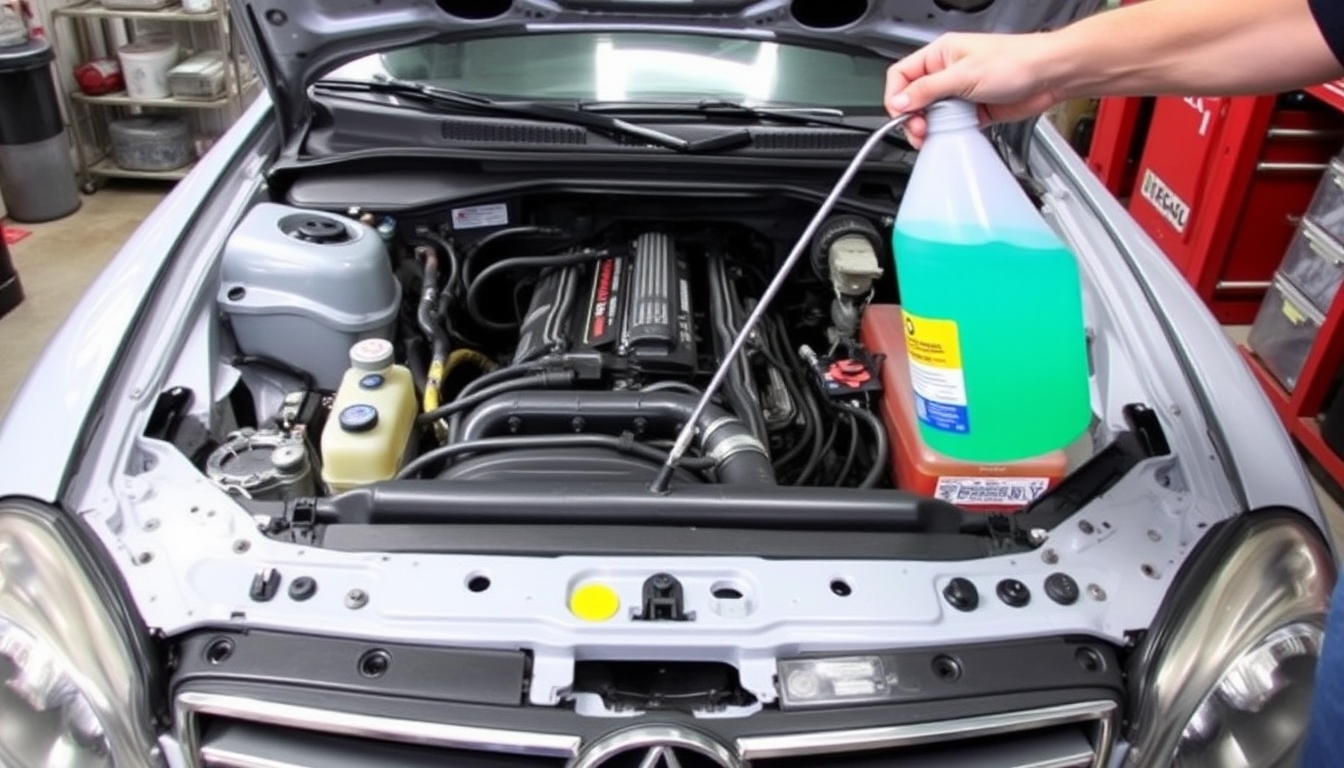Welcome to our informative guide on DIY car freon refill! If you’re looking to optimize your car’s cooling system and save some money, this step-by-step tutorial is just what you need. We’ll walk you through the process of safely and efficiently refilling your car’s freon, ensuring optimal cooling performance. Whether you’re a seasoned DIY enthusiast or a curious car owner, this guide will provide you with all the necessary information to get the job done right. So let’s dive in and learn how to give your car’s cooling system a refreshing boost!
Understanding the Basics of Car Freon
Before we delve into the process of DIY car freon refill, it’s important to have a clear understanding of what freon is and how it functions within your car’s cooling system.
1. What is Car Freon?
Car freon, also known as refrigerant, is a chemical compound that plays a crucial role in the cooling process of your car’s air conditioning (AC) system. It absorbs heat from the air inside your car and releases it outside, resulting in cool air circulation.
2. Different Types of Car Freon
Over the years, different types of freon have been used in car AC systems. The most common ones include Freon-12 (R-12) and its successor, R-134a. It’s essential to know which type of freon your car requires, as using the wrong one can lead to system malfunctions and potential damage.
3. Signs of Low Freon Levels
When your car’s freon levels are low, it can impact the cooling efficiency of your AC system. Some common signs of low freon levels include diminished cooling performance, longer time to reach desired temperature, strange noises, and leaks near the AC unit.
Now that we have a solid understanding of car freon, its types, and signs of low levels, let’s move on to the step-by-step process of refilling your car’s freon yourself.
DIY Car Freon Refill: Step-by-Step Guide
Refilling your car’s freon can be a straightforward process if done correctly. Follow these steps to ensure a successful DIY car freon refill:
Gather the Necessary Tools and Materials
Before you begin, make sure you have the following tools and materials:
- A freon refill kit specific to your car’s AC system
- Safety goggles and gloves
- A pressure gauge
- A thermometer
- A wrench or pliers
- A cloth or towel
Locate the Low-Pressure Port
Next, you’ll need to locate the low-pressure port in your car’s AC system. Refer to your car’s manual or consult online resources to find its exact location. Generally, the low-pressure port is located near the AC compressor.
Prepare the System for Refilling
Ensure your car’s engine is turned off and the AC system is not running. Use the wrench or pliers to remove the cap from the low-pressure port. Wipe away any debris or dirt using a cloth or towel.
Connect the Refill Kit
Take the freon refill kit and connect the hose to the low-pressure port. Ensure a secure connection to prevent any leaks during the refill process.
Monitor the Pressure and Temperature
Put on the safety goggles and gloves for protection. Start the car’s engine and turn on the AC system to the maximum cooling level. Monitor the pressure gauge and temperature readings throughout the refill process, ensuring they stay within the recommended range.
Refill the Freon
Follow the instructions provided with your freon refill kit to add the appropriate amount of freon to your car’s AC system. Be cautious not to overfill, as it can lead to system damage.
Continue to the next section to learn the remaining steps to complete the DIY car freon refill process successfully.
Finalizing the DIY Car Freon Refill
In this section, we’ll cover the remaining steps to finalize the DIY car freon refill process:
Inspect for Leaks
After refilling the freon, it’s crucial to inspect the AC system for any leaks. Use a leak detection kit or soapy water to check for any bubbles or signs of leakage around connections, hoses, or fittings. If you detect a leak, it’s recommended to consult a professional for repairs.
Recheck Pressure and Temperature
Turn off the car’s engine and AC system. Recheck the pressure gauge and temperature readings to ensure they are within the recommended range. If the readings are not within the specified limits, it may indicate an issue with the AC system that requires further inspection.
Replace Cap and Clean Up
Once you’ve confirmed that everything is functioning properly, replace the cap on the low-pressure port securely. Clean up any spills or mess that may have occurred during the refill process to maintain a tidy workspace.
Test the Cooling Performance
Start your car’s engine and turn on the AC system. Monitor the cooling performance to ensure that the air is blowing cold and the desired temperature is reached efficiently. If you notice any issues or a decrease in cooling performance, it’s advisable to consult a professional for further evaluation.
Maintenance and Regular Checks
To maintain optimal cooling performance, it’s essential to perform regular checks on your car’s AC system. Monitor freon levels, inspect for leaks, and ensure all components are in proper working condition. Regular maintenance will help prevent potential issues and prolong the lifespan of your AC system.
By following these steps and taking proper care of your car’s AC system, you can enjoy a refreshing and efficient cooling experience on the road. Remember, if you are unsure or uncomfortable with any part of the DIY car freon refill process, it’s always best to seek assistance from a qualified professional.
Tips for a Successful DIY Car Freon Refill
To ensure a successful DIY car freon refill and enhance your overall experience, consider the following tips:
1. Safety First
Prioritize your safety by wearing safety goggles and gloves throughout the refill process. Work in a well-ventilated area to avoid inhaling any potentially harmful fumes.
2. Read the Instructions
Before beginning the refill process, carefully read and understand the instructions provided with your freon refill kit. Following the manufacturer’s guidelines is crucial for a successful refill.
3. Seek Professional Help if Unsure
If you are unsure or uncomfortable with any step of the DIY car freon refill process, it’s best to seek assistance from a professional. They have the expertise and knowledge to handle the task safely and efficiently.
4. Regularly Monitor Freon Levels
Regularly monitor your car’s freon levels to ensure optimal cooling performance. If you notice a decrease in cooling efficiency or suspect a freon leak, address the issue promptly to prevent further damage to the AC system.
5. Maintain Cleanliness
Keep the area around the low-pressure port and other AC system components clean and free from debris. This will prevent contamination and potential damage to the system.
6. Follow Maintenance Schedule
Adhere to your car manufacturer’s recommended maintenance schedule for the AC system. Regular maintenance will help identify and address any potential issues before they escalate.
7. Stay Informed
Keep yourself updated with the latest information and guidelines regarding car freon and AC system maintenance. This will help you make informed decisions and ensure the longevity of your car’s cooling system.
By following these tips, you can confidently embark on your DIY car freon refill journey while prioritizing safety and maximizing the effectiveness of your AC system.
Conclusion: Enjoy a Cool Ride with DIY Car Freon Refill
Refilling your car’s freon can be a rewarding and cost-effective way to maintain optimal cooling performance. With the right tools, knowledge, and safety precautions, you can successfully complete the DIY car freon refill process.
Save Money and Time
By learning how to refill your car’s freon yourself, you can save money on professional services and avoid unnecessary trips to the mechanic. With regular maintenance and checks, you can ensure your AC system functions efficiently, providing you with a comfortable and cool ride every time.
Empowerment Through DIY
Embarking on a DIY project like a car freon refill can be empowering. It allows you to take control of your car’s maintenance and gain a deeper understanding of its cooling system. Plus, successfully completing the refill process gives you a sense of accomplishment.
Know Your Limits
While a DIY car freon refill can be a great option, it’s important to recognize your limits. If you encounter any complications or feel unsure about any aspect of the process, it’s always best to seek professional help. Your safety and the proper functioning of your car’s AC system should always be prioritized.
Now that you have a comprehensive understanding of the DIY car freon refill process, it’s time to gather the necessary tools, follow the steps meticulously, and enjoy a cool and comfortable ride in your car. Remember to prioritize safety, read the instructions carefully, and perform regular maintenance to keep your AC system in top condition.
Happy DIY car freon refilling!
Frequently Asked Questions (FAQs)
Here are some common questions that car owners often ask about DIY car freon refill:
1. Is it safe to refill the freon in my car by myself?
When done correctly and following safety precautions, DIY car freon refill can be safe. However, it’s important to prioritize your safety and have a good understanding of the process before attempting it. If you’re unsure or uncomfortable, it’s best to seek professional assistance.
2. How do I know if my car’s AC system requires a freon refill?
If you notice a decrease in cooling efficiency, longer time to reach desired temperature, or strange noises coming from your AC system, it may indicate low freon levels. However, it’s recommended to consult a professional to accurately diagnose and address any issues with your AC system.
3. Can I use any freon refill kit for my car?
No, it’s crucial to use a freon refill kit that is specifically designed for your car’s AC system. Different car models may require different types of freon, so ensure you use the correct one to avoid potential damage to your AC system.
4. How often should I refill my car’s freon?
There is no set timeframe for refilling car freon as it depends on various factors such as usage, system efficiency, and potential leaks. It’s best to monitor your AC system’s cooling performance regularly and refill the freon when needed.
5. Can I reuse the freon from my old car?
No, it’s not recommended to reuse freon from an old car. Freon should be properly disposed of or recycled according to local regulations. Using recycled or reused freon may lead to system malfunctions and is not environmentally friendly.
These FAQs aim to address some common concerns about DIY car freon refill. If you have specific questions or unique situations, it’s advisable to consult a professional for personalized advice and guidance.
Expert Tips for DIY Car Freon Refill
Here are some expert tips to enhance your DIY car freon refill experience:
1. Check for System Compatibility
Before purchasing a freon refill kit, ensure that it is compatible with your car’s AC system. Check the manufacturer’s specifications and consult professionals or online resources if needed.
2. Avoid Overfilling
Overfilling your car’s freon can lead to system damage and reduced cooling performance. Follow the manufacturer’s instructions and recommended levels to ensure proper functioning.
3. Use Safety Equipment
Always wear safety goggles and gloves to protect yourself from potential freon leaks and harmful chemicals. Additionally, work in a well-ventilated area to minimize exposure to fumes.
4. Perform Regular System Maintenance
Don’t wait until you encounter cooling issues to refill the freon. Regularly inspect your car’s AC system, check for leaks, and perform maintenance to prevent potential problems and ensure optimal performance.
5. Consider Professional Inspection
If you’re unsure about the condition of your car’s AC system or suspect any underlying issues, consider getting a professional inspection. They can identify any leaks, diagnose problems, and provide appropriate solutions.
6. Dispose of Old Freon Properly
When disposing of old freon, follow local regulations for proper disposal or recycling. Improper disposal can harm the environment and may be subject to legal consequences.
7. Keep Records of Maintenance
Maintain a record of all freon refills, inspections, and repairs performed on your car’s AC system. This will help you track its maintenance history and identify any recurring issues.
By following these expert tips, you can ensure a smoother and more successful DIY car freon refill, leading to optimal cooling performance and a comfortable driving experience.
When to Seek Professional Help
While a DIY car freon refill can be a cost-effective solution, there are certain situations where it’s best to seek professional help:
1. Frequent or Persistent Issues
If you frequently experience cooling issues or notice persistent problems with your car’s AC system even after refilling the freon, it’s advisable to consult a professional. They can diagnose the underlying cause and provide appropriate solutions.
2. Freon Leaks
If you suspect a freon leak or notice signs of leakage such as oily residue or a strong chemical odor, it’s crucial to consult a professional. Freon leaks require proper detection, repair, and handling to ensure safety and prevent further damage to the system.
3. Complex AC System Problems
If you’re unfamiliar with the intricacies of your car’s AC system or encounter complex issues such as compressor failure or electrical problems, it’s best to leave the repairs to a qualified professional. They have the expertise and experience to handle such situations effectively.
4. Manufacturer’s Warranty
If your car is still under the manufacturer’s warranty, it’s recommended to consult an authorized service center for any AC system-related issues. Attempting DIY repairs or modifications may void the warranty.
5. Lack of Confidence or Experience
If you lack confidence or experience in handling automotive repairs, it’s always safer to entrust the job to a professional. They can ensure the proper handling of freon and the overall safety of your car’s AC system.
Remember, your safety and the proper functioning of your car’s AC system should be the top priorities. Seeking professional assistance when needed can help prevent further damage, ensure accurate diagnosis, and provide long-lasting solutions.
In conclusion, a DIY car freon refill can be a practical and rewarding solution to maintain optimal cooling performance in your vehicle. By following the step-by-step guide, gathering the necessary tools, and taking safety precautions, you can successfully refill the freon yourself and enjoy a cool and comfortable ride.
Remember to understand the basics of car freon, locate the low-pressure port, and carefully follow the instructions provided with your freon refill kit. Regular maintenance, including monitoring freon levels and inspecting for leaks, is essential to ensure the efficiency of your car’s AC system.
While a DIY approach can save you money, it’s important to know your limits. If you encounter complications, suspect leaks, or lack confidence in handling the refill process, it’s best to seek professional assistance. Professionals can diagnose complex issues, handle freon leaks safely, and provide expert solutions.
By prioritizing safety, staying informed about your car’s AC system, and performing regular checks and maintenance, you can enjoy a cool and pleasant driving experience. Whether you choose to embark on a DIY car freon refill or seek professional help, keeping your AC system in top condition will ensure a comfortable ride on hot summer days.
So, go ahead and equip yourself with the knowledge and tools to confidently tackle a DIY car freon refill, or reach out to professionals for assistance when necessary. Stay cool and enjoy the journey!






